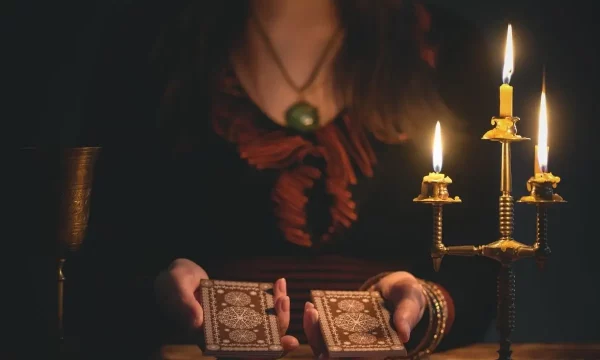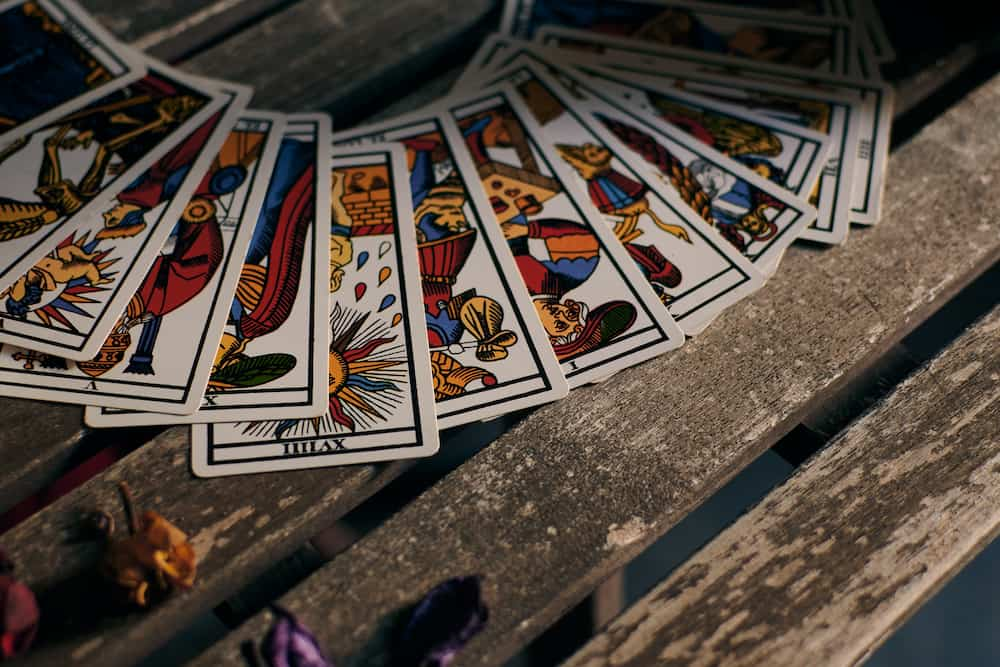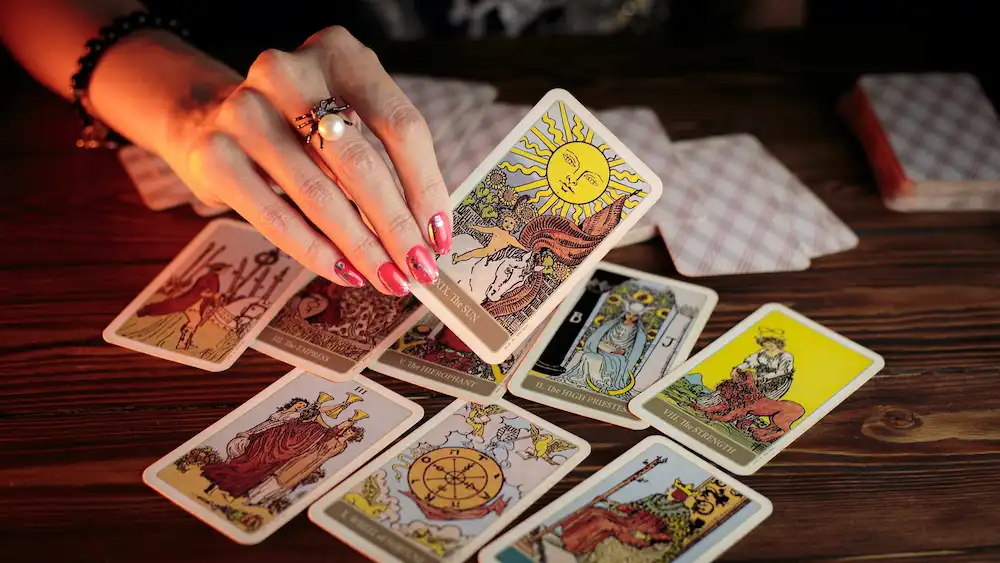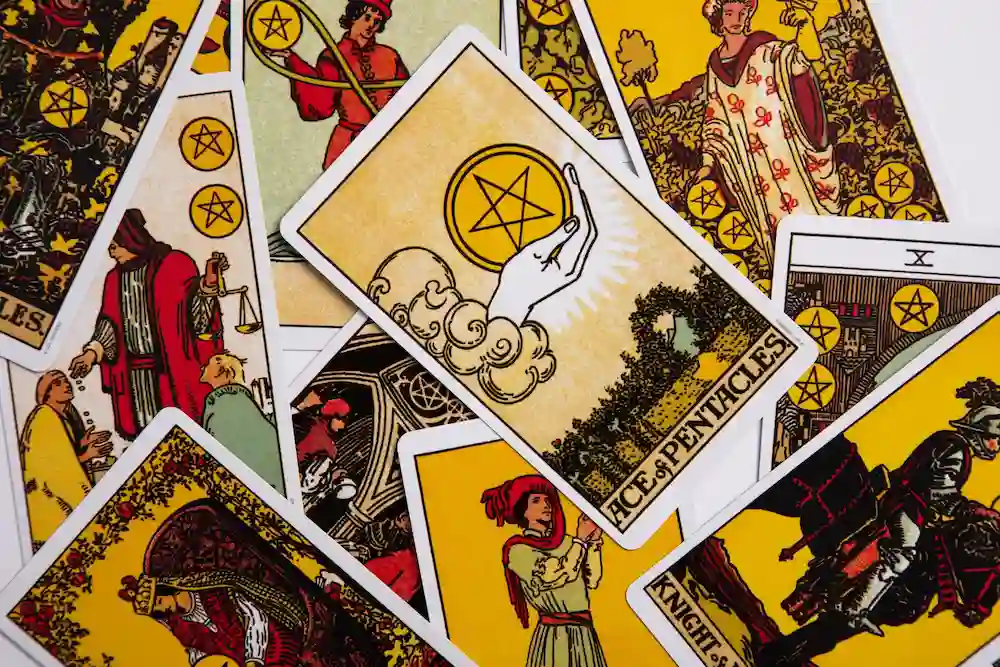
Is Tarot Witchcraft?
Last Updated: July 26, 2022
Simply put, Tarot is a deck of cards and a form of Divination. Divination is a collection of methods and tools used to seek out knowledge. Tarot is one of the most popular Divination tools, with hundreds of designs and adaptations to suit anyone’s needs. However, Tarot is so much more than a Divination tool.
Tarot started out as a pack of playing cards used for entertainment purposes but quickly took on a prominent role in Divination. Playing cards were popular as far back as the late-1300s and the first documented Tarot decks were circulated around the mid-1400s in Renaissance Italy.
That’s not to say Tarot wasn’t used prior to this, we’re just not sure. It’s quite likely though that the cards found in Italy were influenced by a variety of spiritual approaches and practices, philosophies and esoteric teachings from astrology to numerology, and beyond.
Traditionally a Tarot deck is formed of seventy-eight cards, separated into two parts: the Minor Arcana and the Major Arcana. There are four suits within the Minor Arcana, known as (but not always) Cups, Wands, Swords and Pentacles. Usually, one would have a question or situation in mind and pull cards in order to gain insights.
Tarot isn’t here to tell you whether you need to break up with your boyfriend or if you’re going to win the lottery. It’s here to delve into your subconscious and pull out things you might not be aware of, or might not want or be able to acknowledge otherwise.

Why is the Tarot so popular with witches?
One of the most influential Tarot decks to date was created in 1909 by occultist Arthur Edward Waite and artist Pamela Colman Smith, known as the Rider-Waite-Smith deck (sometimes just referred to as the Rider-Waite).
Arguably one of the most well-known and widely used decks out there, the Rider-Waite deck has become a standard from which many subsequent decks are moulded because of its reimagined modernised interpretations and imagery.
Not only that but this Divination tool is an amazing opportunity for us to learn about ourselves on numerous levels, as well as assist us in exploring a variety of disciplines from astrology to psychology.
Tarot is a teacher and it expands our knowledge and understanding of many inter-linked approaches. So, not only can it help us to explore various disciplines, but it can also assist us to navigate different spiritual pathways such as witchcraft.
Why does the media depict witches with the Tarot?
One of the oldest negative reviews for Tarot can be found not on any popular review platform, but in the Bible. Leviticus 19:31 to be exact, which reads: “Do not turn to mediums or necromancers; do not seek them out, and so make yourselves unclean by them.” Tarot has been associated with fortune-telling and predicting the future, and has been linked to magic and witchcraft, and from that labelled as something which is wrong or unholy.
This negative stigmatism makes for good scary stories, films, TV shows and books which is why you constantly see witches with Tarot. These popular formats of media have used tropes around Tarot and witchcraft for years to create dark, mysterious and edgy content which evokes in us a sense of intrigue and fear.
Today Tarot and witchcraft are more popular than ever, with examples of people practising both strewn all over social media. This new occult resurgence has flared up old superstitions and misconceptions, including the idea that Tarot and witchcraft work hand-in-hand.
Do all witches know the Tarot?
Tarot cards are a tool for anyone who wishes to use them. You might wish to use them as a Divination tool, as entertainment, or for decoration/collection.
There are many different people who read the Tarot, from witches to Pagans and Druids, to Buddhists, Agnostics, Atheists and Christians. Not all witches practise or even like the Tarot, but yes, there are instances where Tarot and witchcraft overlap. Essentially it is down to you and your practice

Witchcraft and Modern Feminism
The witch has commonly been seen as the feminist boogie(wo)man of choice for centuries. Take the Malleus Maleficarum by Catholic clergyman Heinrich Kramer in 1486. This treatise on witchcraft continually suggested that women are more likely to be witches due to their female qualities.
Essentially the document informs people that women are more susceptible to possession from demons and more prone to practising witchcraft due to assumed female characteristics such as “loose tongues” and “lack of physical strength”.
Then there are the typical witch stereotypes which fixated on those that were “more likely to be female, elderly, poor, isolated from society, or sexually deviant, all of which are characteristics that were outside of the gendered expectations.” – Witchcraft, Female Aggression, and Power in the Early modern Community, Edward Bever, 2002. Basically, if you were perceived to be ugly, old, poor, strange or deviated from societal norms in any way, you might be a witch.
“To reclaim the word witch is to reclaim our right, as women, to be powerful. To be a witch is to identify with 9 million victims of bigotry and hatred and to take responsibility for shaping a world in which prejudice claims no more victims.” – The Spiral Dance, Starhawk, 1979.
The Feminist Spirituality Movement emerged in the 1970s during the second wave of the Modern Feminist Movement in the USA. It aimed to reclaim the power, value and dignity of women, bring about justice and equality for all, and focused on women’s heritage, women’s bodies and women’s work replacing patriarchal and kyriarchal societies.
Feminist Spirituality started to challenge religions, like Christianity and Judaism, and their sexist leadership, examining traditions surrounding female subordination and rejecting teachings which discouraged or denied women’s selfhood.
Feminists from all walks of life, all religious or secular backgrounds, started to search for spiritual resources in their own sacred traditions. For example, Native American feminists explored woman-centred and mother rituals, Wiccan feminists revitalised the Goddess, and Murjeristas gave a voice to women struggling for liberation.
Conclusion – Tarot for empowerment
One of the reasons the Tarot is so popular is because it’s another tool by which we can gain autonomy in our lives. We can use this form of Divination to empower, support and enrich our journeys.
Tarot isn’t just a party trick, it’s a powerful tool for self-reflection. It can be used for a variety of reasons, such as:
- Empowerment
- Problem-solving
- Self-development
- Creativity
- Dream interpretation
- Meditation
- Visualisation
- Education
- Intellectual stimulation
- Divination
- Intuitive and psychic development
- Communication
Tarot is like a mirror, reflecting current situations, thoughts and emotions. It can highlight energies surrounding us and the issue; make us aware of patterns that may not be serving our highest good; affirm or refine our purpose and; assist us in formulating a plan with actionable steps to help us move through life’s ups and downs.
This form of Divination can absolutely be seen as a form of self-care. Incorporating the Tarot into your everyday routine can help to change your life significantly. On a simple level pulling cards promotes mindfulness, can help you get in touch with yourself, your thoughts and feelings, and can ground you in the present moment. On a more complex level Tarot can help us navigate life and assist us in becoming stronger, healthier, and happier people.
Tarot has an incredible ability to change with time and reflect the culture of the moment. The same can be said of witchcraft. Both Tarot and witchcraft have evolved over time, and one practice can be enriched by the other interchangeably. But they do not have to always go hand-in-hand.
Witchcraft and Tarot both strive to impart wisdom to the person practising. They both act as tools and systems which bestow agency on a person who might be seeking empowerment. They both reveal our ability to make positive changes in our lives, and they both allow us to connect to something greater than ourselves.
The truth is Tarot and witchcraft are nuanced and distinct. Witchcraft can mean different things to different people, but it is a practice and a lifestyle. Tarot is a tool. The two can work together, or separately.
Tarot is a form of empowerment.

I love curating divination experiences for those invested in spiritual growth with secular honest vibes. I am that witch you come to for these honest, interesting and beneficial divination experiences!
Continue your tarot journey ✨
This page is part of our collection of articles on learning about tarot. If you enjoyed reading this, then you will enjoy the following articles.

There are many different versions of the Tarot card deck, and each one can have a different number of cards.

“Can you use someone else’s tarot cards?” and “can other people touch your tarot cards?” are two questions that come up quite often.

Let’s take a look at different ways to store tarot decks and ensure your cards remain safe and protected in between tarot readings.

Tarot belongs to a form of divination called cartomancy, and in this article, we will explore what tarot cards are used for.
